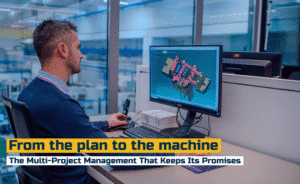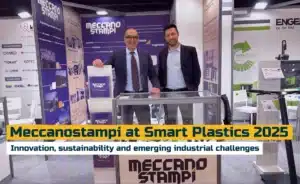In the world of injection moulding, innovation is not optional—it’s essential. As demand grows for quality, customization, and efficiency, industrial automation continues to be a key driver of competitiveness.
At Meccanostampi, the focus is always on the future. That’s why we sat down with Paolo Paniz, Process Engineering Manager, to understand how automation is redefining production timelines, methodologies, and the overall manufacturing vision.
What is your role within the company and what are your specific responsibilities?
“I’m responsible for all industrial processes related to injection moulding. My work focuses particularly on identifying and implementing technological solutions that make production more efficient, repeatable, and controlled.
I oversee the development of robotic cells, the design of gripper systems, and the integration of automated systems within our production phases. The goal is twofold: to improve operational performance and ensure increasingly higher quality standards.”
What is the added value of automation in injection moulding today?
“Automation today goes far beyond improving productivity. It’s a fundamental tool for achieving repeatability, traceability, and process safety.
Working with robotic cells means eliminating many of the variables introduced by manual intervention, reducing scrap, enhancing process control, and freeing up human resources from repetitive tasks. This enables us to reallocate talent to more strategic activities where creativity and experience truly make a difference.”
Can you share a concrete example of a recent automation project?
“One of our most recent projects was the development of a custom gripper made using 3D printing technology. This custom component allowed us to integrate a secondary operation—previously performed in a separate area—directly within the injection moulding cell.
The result? A more streamlined, reliable, and faster process, with no intermediate steps or unnecessary handling. It’s a perfect example of how well-designed automation not only speeds up production but also enhances overall quality and consistency.”
How important is collaboration with external partners in developing automation systems?
“Extremely important. The best solutions always come from collaboration. We bring deep expertise in injection moulding processes, while our partners provide knowledge in robotics, sensing technologies, mechatronics, and automation systems.
Working together openly and constructively allows us to co-develop tailor-made systems that are fully aligned with the final product’s requirements. Thanks to this synergistic approach, we often manage to anticipate the client’s needs—sometimes even before they are fully defined.”
How does 3D printing support innovation in your processes?
“3D printing is an incredibly powerful innovation tool. It allows us to rapidly prototype functional custom parts, test solutions, and dramatically shorten development times.
We use this technology primarily to create grippers, technical supports, and other components that are difficult to standardize. Once validated, we can decide whether to move to series production or keep them for specific applications. It’s the ideal ally for a company like ours that works on complex products and needs to stay agile in adapting and improving.”
How do you envision the future of injection moulding in the context of Industry 4.0?
“The future will be increasingly connected, predictive, and intelligent. We are already implementing solutions for real-time process monitoring, predictive maintenance, and automated data analysis to prevent faults and inefficiencies.
But the real leap will be cultural: collecting data won’t be enough—we’ll need to know how to interpret it and use it to make quick, informed, and strategic decisions. Industry 4.0 isn’t just about sensors and software; it’s about people who can make machines talk.”
Technology, Expertise, Vision
At Meccanostampi, industrialization is a true innovation lab, where cutting-edge technology meets experience and a deep-rooted culture of continuous improvement.
From advanced automation to 3D printing, from robotic cells to real-time data collection—every decision is made with a clear goal: to make our production processes more robust, efficient, and flexible, fully aligned with the needs of the most demanding markets.
Because for us, innovation is never an end in itself. It’s a tool to deliver quality, safety, and competitiveness—in every single part we mould.



